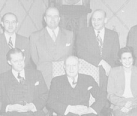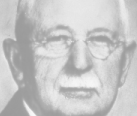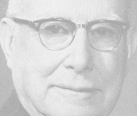news No. 4 June 2000
President's Message
On legacy and website
Since I missed our annual meeting last November because of my sabbatical leave, I start this message with my thanks, on behalf of GPSO, to Dr. Orhan Tuncay for his masterful stewardship of the Society during his presidential term. In addition to managing the affairs of the society with insight and selfless efforts, and planning the 1999 annual meeting, he managed the organization of our web "home". The site includes facts from the history of the society (historical notes, and to date, [recommended reading] profiles of John Valentine Mershon [first President of our Society] and Andrew Francis Jackson), updates on activities and events, copies of the newsletter, and several other features. Other sites are accessible via links to locations of interest to other features. Input from members is appreciated through Dr. Tuncay, whose address can be found on http://www.gpso.org. Welcome to GPSO.
On meetings: 2000, a departure from tradition
From the effects of orthognathic surgery on growth, through temporomandibular joint pathology and its influence on orthognathic outcome, to issues of distraction osteogenesis, comments by GPSO members on last November's annual GPSO presentation by Dr. Lary M. Wolford of Texas were laudiatory.
The 2000 meeting promises to be another excellent meeting. Dr. Richard McLaughlin of California will address "Intra and Inter Arch Mechanics." For this 2-day course (November 10-11, 2000), a special fee is extended to GPSO members whom I invite to follow the instructions for registration sent with the program, and to register through Dr. Mark Mele, GPSO's new Secretary-Treasurer. Not only is the length of the meeting a departure from our regular annual gatherings; the venue, the Union League in Center City Philadelphia, facilitated through the efforts of Dr. Tuncay, will provide a fitting "millennial" setting. 3M Unitek is a generous sponsor of the event, and they deserve our heartfelt thanks through the care of their regional manager, Mr. Dean Exas.
Because of administrative details, GPSO did not participate at the 2000 Liberty Dental Conference. Dr. Joseph McCormick, the new Director on GPSO's Board, will assume the responsibility of coordinator of this event next year, shouldered by Dr. Patty Werther who carried this task admirably for the past 6 years. A policy of three presentation by graduates of Philadelphia's three orthodontic programs has proven to be enriching for planners, speakers, and participants. Liberty in equity.
GPSO: an anchor of interaction
Thanks to the dedication of its officers and the sustained support and interest of its members, GPSO is meeting its goals of continuing education to the orthodontic community of the tristate area. While the board calls on more members to participate, our annual meeting practically stands as the anchor of our activities, and provides both an educational and social frame of interaction, not only to members, but also to the thirty or more residents of the "tri" programs in our midst. In some way, GPSO is the local anchor of activities and interaction for these postdoctoral programs. In this context, more is planned and should come in the future. Our society's mission statement may actually be brotherly education in this Greater Philadelphia.
Joseph G. Ghafari, DMD
Greetings From Delaware
Invisalign has come to Delaware and both our orthodontists and patients are excited about having yet another choice of treatment. Several of us have taken the Invisalign course and more are planning on it. We remain prudent in our recommendations but are happy that the specialty can benefit from cutting edge technology. The New Journal of Wilmington recently ran an article on Invisalign that has stimulated much inquiry from the public at large.
I recently attended the Governmental Affairs Conference sponsored by the AAO. It was a three-day conference held in Washington, D.C. You'll be happy to know that the AAO did a wonderful job in organizing a stimulating and informative conference. They updated us on the current legislation that may likely affect our specialty and our patients in the coming year.
We learned the importance of staying in touch with our Senators and Congress(wo)men to make the "grass roots" approach effective. A host of informed speakers presented a clear and concise picture of how things really work "on the Hill". We were honored to have Gen. Hugh Shelton, Chairman of the Joint Chiefs of Staff address us at luncheon one day. My thanks to MASO for allowing me to attend.
Looking forward to seeing all of you at the November meeting!
Connie Greeley
New Jersey
New Jersey has been relatively quiet this past year. Therefore, I am taking this opportunity to let you know that the ABO has established a third pathway to certification. Prior to 1998 there was only one Option toward certification. In 1998, the Board initiated Option II. This pathway was established to allow candidates to begin the certification process earlier. If a candidate selects Option II, he/she prospectively identifies 12 patients from categories one though eight. Then the candidate must complete and present any six of these cases to achieve board certification. This option is especially beneficial for young graduates who take the written examination immediately after graduation, and then associate with other orthodontists who are involved in teaching, since it doesn't require treating large numbers of patients in order to achieve board certification.
Now that most orthodontic residents take the written examination immediately after graduation, the young graduate often runs out of time before completing the Phase III oral and clinical examination in the 10-year time limit. The Board has recognized this difficulty and has established, at the Chicago meeting, a third pathway to help resolve this problem. This pathway, if chosen by the candidate, will allow him/her to take the oral examination between 2 and 5 years after successfully completing the written examination. If a candidate passes the oral examination within the time limit, they will restart their "time clock", so to speak, and will then have 10 years from the oral examination to complete the clinical examination either utilizing Option I or II. By dividing the oral and case report portions of the examination, the Board believes that it will give the candidates more time, and encourage greater numbers of young orthodontists to complete the certification process. If you would like a more detailed description of the pathways available, you will find this at the Board's website, www.americanboardortho.com.
Joe Damone
3D Imaging
THE DEVELOPMENT OF A SYSTEM FOR THREE-DIMENSIONAL IMAGING AND ANIMATION
OF THE CRANIOFACIAL COMPLEX
Orhan C. Tuncay, Michiel J. Nuveen, Can X. Nguyen, and John Slattery
Department of Orthodontics,
Temple University, School of Dentistry
3223 N. Broad Street,
Philadelphia, PA 19140
The ultimate goal of orthodontic treatment is to re-arrange the craniofacial complex relationships in a harmonious manner. This harmony must not only be functional, but but must also be esthetically pleasing. Clearly, this process must take into account the relationships in all three spatial axes. Oddly enough, while orthodontic treatment affects all three dimensions, many of the current tools of diagnosis employ only a two-dimensional representation of the patient. Of course, there exist hospital-based three-dimensional (3D) imaging systems (MRI or CT scans). Unfortunately, these systems are neither accurate enough for the precision of orthodontic treatment, nor practical for in-office use. The full text of our report discusses the characteristics of the three different imaging systems we had developed over the past few years.


